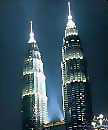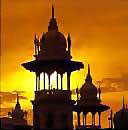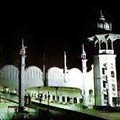|
|
|
 |
Popular
Places |
  Kuala
Lumpur (KL as the locals call it) is the capital of Malaysia. From its
centralized position, which spans 243.6 sq. km, the ultra-modern nerve
center of Malaysia expands outwards to embrace the world. Discovering
KL is like traveling through a time tunnel. Here, vivid traces of history
continue to influence and inspire a country set on becoming a fully industrialized
nation by the year 2020. Ultra-modern skyscrapers stand magnificently
next to rows and rows of quaint old shop houses while haute cuisine are
located beside simple hawker stalls. Kuala
Lumpur (KL as the locals call it) is the capital of Malaysia. From its
centralized position, which spans 243.6 sq. km, the ultra-modern nerve
center of Malaysia expands outwards to embrace the world. Discovering
KL is like traveling through a time tunnel. Here, vivid traces of history
continue to influence and inspire a country set on becoming a fully industrialized
nation by the year 2020. Ultra-modern skyscrapers stand magnificently
next to rows and rows of quaint old shop houses while haute cuisine are
located beside simple hawker stalls.
In the beginning there
was nothing but a lot of mud. Hence begins an accurate but unappealing
chronicle of KL's origins. Returning to its roots may seem a waste of
effort as this capital, lying in the heart of the Peninsula has never
really left its past. Kuala Lumpur (Muddy Estuary), started off as a little
village at the confluence of Klang and Gombak rivers and was chronicled
to have been established by a group of enterprising miners led by one
"Yap Ah Loy" or better known these days as Kapitan China. As time flew,
Kuala Lumpur grew. Today, the city is one of Asia's most vibrant and aspiring
cites. It is the focal point for business ventures and is enjoying an
enormous amount of wealth from foreign investment. The city is well connected
with excellent roads, rails, and air networks such as the newly completed
and functional Kuala Lumpur International Airport (KLIA) in Sepang. The
capital has also recently hosted the 16th Commonwealth Games 1998 with
much success and grandeur! On narrow city streets and six-lane super highways,
expensive European cars and more modest Japanese models rub hubcaps daily
with the ever growing rash of Protons and Peroduas (results of Malaysia's
very own automobile industry). Meanwhile, steel and glass skyscrapers
of every conceivable design sprout almost indiscriminately amongst the
older, more sedate buildings of the colonial past.
Getting
Around
 Kuala
Lumpur has an efficient transportation network that gives the independent
visitor the freedom to move around without much hindrance. Buses and taxi
services are available at just about every nook and corner of the city.
Furthermore, you may want to opt for the Light Rail Transit (LRT) if you
wish to avoid traffic jams during peak hours. The KTM Commuter train also
connects the city to nearby towns. Traffic congestion has improved tremendously
with the operation of the LRT and various new highways such as the New
Klang Valley Expressway (NKVE). Kuala
Lumpur has an efficient transportation network that gives the independent
visitor the freedom to move around without much hindrance. Buses and taxi
services are available at just about every nook and corner of the city.
Furthermore, you may want to opt for the Light Rail Transit (LRT) if you
wish to avoid traffic jams during peak hours. The KTM Commuter train also
connects the city to nearby towns. Traffic congestion has improved tremendously
with the operation of the LRT and various new highways such as the New
Klang Valley Expressway (NKVE).
Top of Page
|
